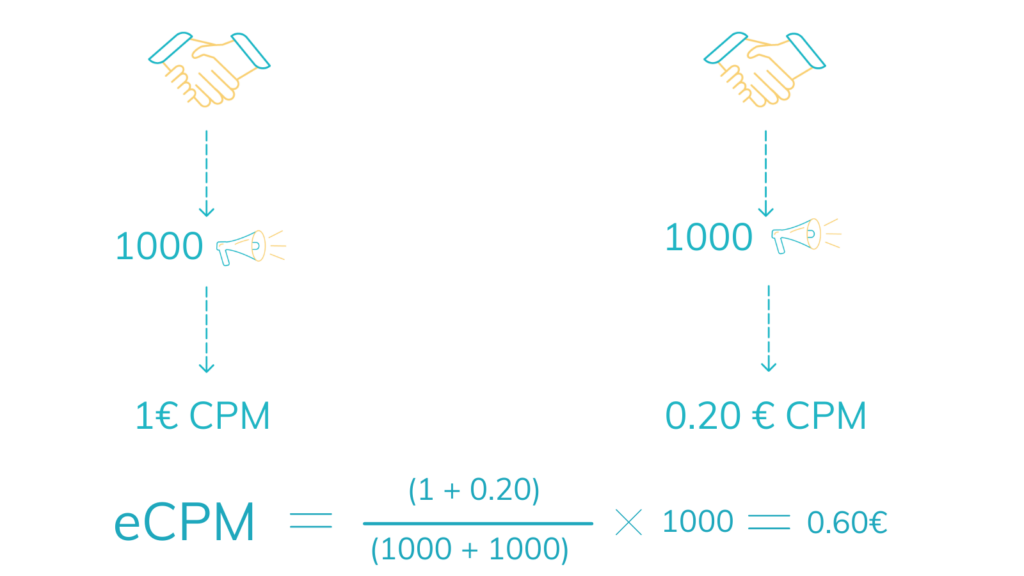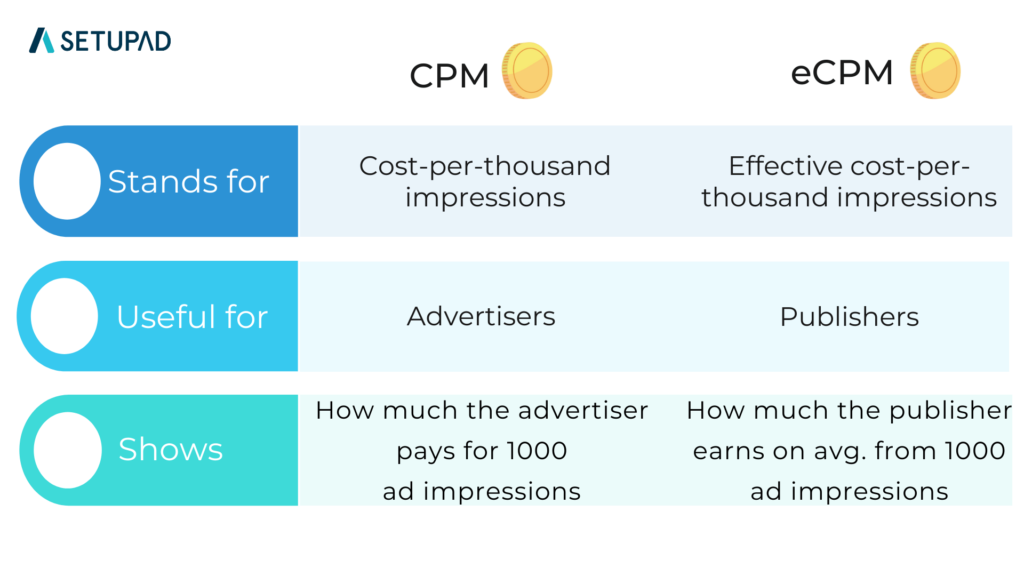eCPM vs CPM | Differences, Formula and How to Calculate?
eCPM and CPM are one of the most common monetization metrics out there. However, publishers often get confused about which one to look at when assessing the performance of their ad campaigns.
We have compiled the main differences regarding eCPM and CPM with specific examples.
Let’s dive in!
What is CPM?
CPM stands for cost-per-thousand impressions, or “Cost Per Mille”. It’s a fixed price advertisers bid or pay for each 1000 ad impressions. For publishers, CPM represents the revenue generated from these 1000 ad impressions.
The CPM price is usually high if the website’s traffic is valuable meaning advertisers will be willing to pay more for your ad impressions.
CPM Formula
The formula for CPM is the total cost of an ad campaign divided by the number of ad impressions and multiplied by 1000.

How to calculate CPM?
To make the CPM calculation formula more understandable, let’s look at the example.
Let’s imagine that the publisher earned 1000€ by selling 1M ad impressions to a particular advertiser. The calculated CPM would be 1€. This means that the publisher will earn 1€ for every 1000 ad impressions he sells to that advertiser.
(1000€ / 1M) x 1000 = 1€ (CPM)

What is eCPM?
eCPM stands for effective cost-per-thousand impressions, or effective “Cost Per Mille”. Both eCPM and CPM illustrate the ad revenue generated by the publisher from 1000 ad impressions.
The main difference is that eCPM is the average of multiple CPMs. Because many advertisers are bidding on each ad impression with different CPMs, the price isn’t fixed. eCPM gives you the combined average of all advertiser bids for your ad impressions.
Some of your ad inventory can even be purchased via different bidding models, for example, CPC. Therefore, eCPM helps to learn how much you can earn across all bidding models. The higher the eCPM, the higher the total ad revenue for the publisher.
Related Article: How to Increase Ad Revenue | Success Formula and Proven Solutions
eCPM Formula
The formula to calculate eCPM (effective cost per thousand impressions) is:
eCPM = (Total Earnings / Total Impressions) x 1000

How to calculate eCPM?
To calculate eCPM, you need to divide the total earnings by the total number of impressions and then multiply the result by 1000.
The eCPM is a useful metric that helps publishers and advertisers understand the revenue generated per thousand impressions, regardless of the pricing model used (CPM, CPC, CPA, etc.). It’s a valuable metric for optimizing ad performance and comparing ad revenue across different campaigns or ad networks.
Here’s an example. Let’s imagine that there were two campaigns on the publisher’s website.
The CPM for the first campaign was 1€ and the CPM for the second was 0.20€. Each campaign bought 1000 ad impressions.
In this case, the publisher generated total revenue of 1.2€ (1€ + 0.20€) per 2000 (1000 + 1000) ad impressions. Therefore, the eCPM is 0.60€ (1.2€ / 2000 x 1000= 0.60€).

As you may notice, none of the buyers paid a CPM of 0.60€. The eCPM metric helped the publisher to understand the average value of his 2000 ad impressions.
Instead of ad campaigns, different SSPs or ad networks can monetize parts of publishers’ ad inventory with a different rate of eCPM. Whether you call it eCPM or CPM, you need to understand and calculate the average value of your sold inventory.
What is the Difference Between CPM and eCPM?
The main difference between CPM and eCPM is that CPM shows the advertiser’s cost of 1000 ad impressions, while eCPM shows how much ad revenue the publisher has generated on average from 1000 ad impressions.

Let’s look at one more example to better understand the main difference between eCPM and CPM.
Example of eCPM and CPM
Imagine that you have a store that sells kiwis (ad inventory). These kiwis represent ad impressions. Since kiwis can go bad, you want to sell them as fast as possible at the highest price possible.
Let’s say you have 10 kiwis in your storage, and each kiwi represents 1M ad impressions. In total, this gives you 10M ad impressions.
Since your kiwis are the best in your town, you sold the first 5 kiwis (5M ad impressions) almost immediately for the CPM price of 1€. This gave you an ad revenue of 5000€.
(5 000 000 /1 000 x 1€ = 5000€)
Then you sold 4 more kiwis (4M ad impressions) for the CPM of 0.20€, which gave you ad revenue of 800€ (4 000 000 /1 000 x 0.20€ = 800€).
Unfortunately, you couldn’t sell the last kiwi because it went bad.
In total, you sold 9 fresh kiwis and earned 5800€ (5000€ + 800€ = 5800€).
In this case, your eCPM would be your total ad revenue (5800€) divided by the total number of ad impressions you sold (9M), giving you an eCPM of 0.64€.
(5800€ / 9M x 1000 = 0.64€)
❗Bear in mind that eCPM doesn’t represent the 10M ad impressions you initially had in total, but only the 9M you sold.
This means you earned on average 0.64€ for every 1000 ad impressions you sold.

Conclusion
As we learned, high CPMs don’t always equal high ad revenue. Neither do they represent the overall value of your sold ad inventory.
Our examples reveal that publishers should focus on eCPM to monitor their overall ad revenue.
In addition, other metrics, like fill rate and rCPM, are very useful in assessing the overall website monetization performance. Continue to learn about them here. But before that, sign up to start monetizing your website with Setupad!


